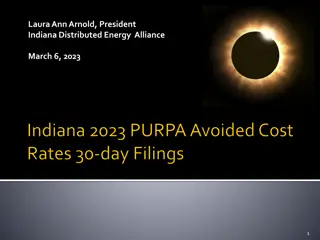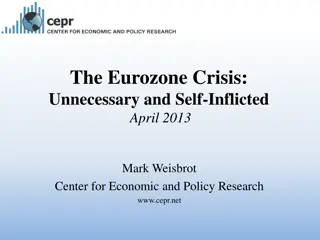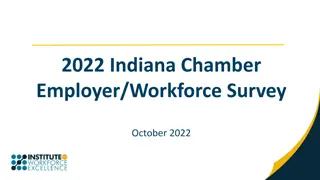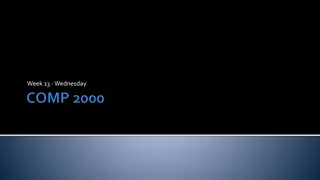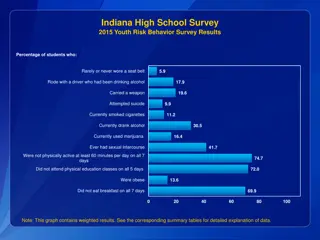Lead Testing Crisis in Indiana: A Silent Public Health Menace
Lead testing in Indiana has unveiled a grave public health crisis. The prevalence of lead exposure in homes, soil, and water poses a significant risk, particularly in communities with outdated infrastructure. The alarming statistics reveal the urgent need for widespread lead testing and remediation efforts to protect the health of residents, especially children. Governmental and societal negligence has perpetuated this issue, leading to long-lasting consequences. Collaborative initiatives and increased public awareness are essential to address this pressing problem effectively.
Download Presentation

Please find below an Image/Link to download the presentation.
The content on the website is provided AS IS for your information and personal use only. It may not be sold, licensed, or shared on other websites without obtaining consent from the author.If you encounter any issues during the download, it is possible that the publisher has removed the file from their server.
You are allowed to download the files provided on this website for personal or commercial use, subject to the condition that they are used lawfully. All files are the property of their respective owners.
The content on the website is provided AS IS for your information and personal use only. It may not be sold, licensed, or shared on other websites without obtaining consent from the author.
E N D
Presentation Transcript
Admitting We Have a Problem Lead Testing in Indiana Jennifer Phillips, J.D. October 27, 2023
A Public Health Problem Leaded paint dust, soil, and water are the most common sources of lead exposure. Over 1.5 million homes - over half of Indiana s housing stock - were built before lead-based paint was banned.1 Indiana is home to 22 EPA Superfund sites containing lead.2 Jacobsville Neighborhood Superfund site in Evansville, Indiana. Image Credit: https://www.courierpress.com/picture-gallery/news/2019/06/26/gallery-jacobsville-neighborhood-super-fund-site-lead-cleanup-years/1572602001/ (June 26, 2019).
A Public Health Problem com/articles/the-top-10-most-dangerous-ads/ (last visited Oct. 12, 2023). 1923 advertisement; Image credit: https://www.collectorsweekly.
A Public Health Problem Looking for Lead, https://www.reuters.com/investigates/graphics/lead-water/en/ (last Over 25% of children tested had BLLs of 5 g/dL or more in some Indiana communities.3 $262 million is lost each year in Indiana due to childhood lead poisoning.4 accessed Oct. 12, 2023). An average of 2.6 IQ points per U.S. adult were lost due to the use of leaded gasoline.5
Repeatedly Ignored Move, IndyStar, https://www.indystar.com/picture-gallery/news/2016/08/22/lead- Image Credit: Lead Pollution Forcing East Chicago Housing Complex Residents to pollution-forcing-east-chicago-housing-complex-residents-to-move/89123242/
Repeatedly Ignored Thispattern of government and societal complacency is apparent across the country and evidenced in the lead poisoning of over half a million children between one and five years of age today. Emily Benfer, in Contaminated Childhood: How the United States Failed to Prevent the Chronic Lead Poisoning of Low-Income Children and Communities of Color 6
Limited Testing for Lead Environmental inspections triggered by a lead-poisoned child7 Limited federal housing inspection requirements Local inspection requirements Home test kits Indiana Collaboration for Lead Action and Prevention Lead Screening Kit, https://www.leadscreeningkit.com/about.
Limited Testing for Lead Most Indiana children even those most at risk are not tested for lead. 9 out of 10 children under seven8 3 out of 4 children estimated to have BLLs of 10 g/dL or more9 3 out of 4 children two or younger on Medicaid10
Outdated Follow-up Services (until 2022) Pre-2022 2020 CDC Indiana Requirements12 Recommendations11 CDC Reference Value: BLL of 5 g/dL Elevated BLL: Confirmed BLL of 10 g/dL A child with 5 to 9.9 g/dL should receive: Environmental assessment Nutritional counseling Follow-up testing A child with less than 10 g/dL must receive: Educational materials
Indiana Children with BLLs 5 g/dL (2016) 1,847 children with BLLs of 5 to 9.9 g/dL Until 2022, hundreds of Indiana children who needed important services were not guaranteed to receive them.13 Number Children Screened Number Children Screened 177children with BLLs of 10 g/dL 10 g/dL 5-9 g/dL
Progress in Indiana Ind. Code 16-46-16.5 House Enrolled Act 1007 (2021) Establishes a fund for the Indiana Department of Health to supply grants to reduce or prevent lead exposure, among other things Funded by federal American Rescue Plan dollars
Progress in Indiana 410 Ind. Admin. Code 29 Updated in 2022 to lower Indiana s Elevated blood lead level from 10 g/dL to 3.5 g/dL Requires county health departments to provide educational materials and offer testing to other children in the home for children with BLL s of 3.5 g/dL or more Requires assessment, environmental inspection, and other services for children with BLL s of 5 g/dL or more
Progress in Indiana Ind. Code 16-41-39.4-11 House Enrolled Act 1313 (2022) Requires health care providers to determine if children under 6 have been screened for lead. If a child has not been screened, the health care provider must offer a test. Effective January 1, 2023 Expires December 31, 2026
Policy Change in Indiana 2017-2018 April 2021 Sept. 2022 Fall 2019 IDOH forms advisory council Research & outreach conducted; core support forms HEA 1007 passed 410 IAC 29 adopted 2017 2023 Spring 2019 Coalition expands; petition written Nov. 2020 March 2022 IN Advisory Committee to U.S. Commission on Civil Rights releases report HEA 1313 passed Jan. 2023 Universal screening begins Summer 2019 Petition delivered to IDOH
Policy Change in Indiana Target the PROBLEM Organize PEOPLE Develop a PLAN
The Work Is Never Done Akeeshea Daniels, former tenant of the West Calumet Complex and community advocate. Image Credit: https://www.chicagotribune.com/suburbs/post-tribune/ct-ptb-east-chicago-awakening-st-0101- Craig Lyons, East Chicago Lead Contamination Galvanizes Residents, 20161230-story.html (Dec. 30, 2016).
References 1. IND. HOUSING DASHBOARD, https://indianahousingdashboard.com/ (last visited Oct. 14, 2023). 2. Superfund Sites Where You Live, ENVIRONMENTAL PROTECTION AGENCY, https://www.epa.gov/superfund/search-superfund-sites-where-you-live (last accessed Oct. 12, 2023). 3. Looking for Lead, https://www.reuters.com/investigates/graphics/lead-water/en/ (last accessed Oct. 12, 2023). 4. ENVIRONMENTAL INJUSTICE: LEAD POISONINGIN INDIANA: A REPORTOFTHE INDIANA ADVISORY COMMITTEETOTHE U.S. COMMISSIONON CIVIL RIGHTS 31 (Nov. 1, 2020), https://www.usccr.gov/files/2020/2020-11-12-Report-Lead-Poisoning-in-Indiana.pdf. 5. Elizabeth Chuck, Lead in Gasoline Blunted the IQ of Half the Population, Study Says, https://www.nbcnews.com/health/health-news/lead- gasoline-blunted-iq-half-us-population-study-rcna19028. 6. Emily Benfer, Contaminated Childhood: How The United States Failed to Prevent the Chronic Lead Poisoning of Low-income Children and Communities of Color, 41 HARVARD ENV. L. REV. 493, 498 (2017). 7. Id. at 546. 8. INDIANA STATE DEPARTMENTOF HEALTH, 2016 CHILDHOOD LEAD SURVEILLANCE REPORT, https://www.in.gov/isdh/files/lead%20report%202016- new.pdf. 9. Eric M. Roberts, et al., Assessing Child Lead Poisoning Case Ascertainment in the US, 1999-2010 Figure 2, 139 Pediatrics (2016). 10. Annual EPSDT Participation Report: FY 2017 Data, https://www.medicaid.gov/medicaid/benefits/epsdt/index.html (Indiana data). 11. LOW-LEVEL LEAD EXPOSURE HARMS CHILDREN: A RENEWED CALLFOR PRIMARY PREVENTION 37, CTRS. FOR DISEASE CONTROL & PREVENTION https://www.cdc.gov/nceh/lead/docs/final_document_030712.pdf 12. 410 Ind. Admin. Code 29 (readopted filed Nov. 2019). 13. INDIANA STATE DEPARTMENTOF HEALTH, 2016 CHILDHOOD LEAD SURVEILLANCE REPORT, https://www.in.gov/isdh/files/lead%20report%202016- new.pdf.







